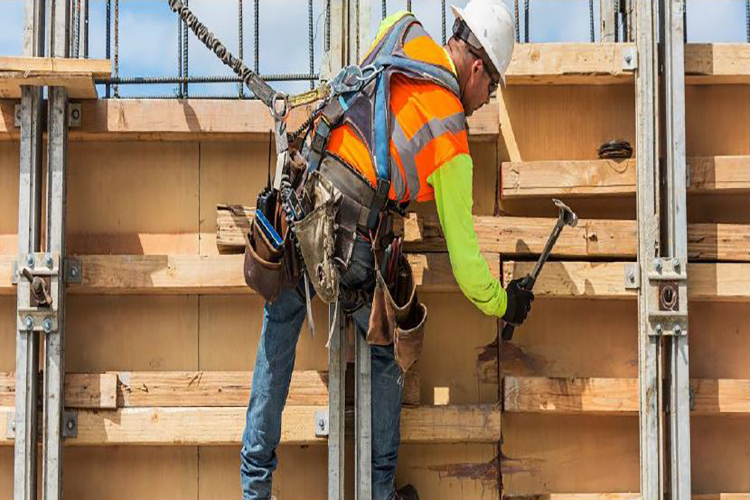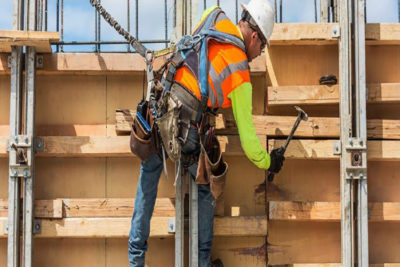In moments of hardship, communities come together to support one another. It’s that support that makes us more reliable and resilient on the other side.
As we continue to navigate this unprecedented situation, every industry is finding themselves in a new normal. The construction industry is no different. The traditional jobsite we’ve all become accustomed to looks a lot different these days. What was once boots on the ground is now sneakers at home, and headsets replace hard hats for some. But even though the day-to-day may not be what we’re used to, the industry is responding in unique ways — from the agility of building prefabricated field-hospitals in three days to using drones to conduct site reviews to limiting the number of workers on site. Digital tools are also enabling collaboration and greater communication as teams quickly scale on new ways of using technology.
Prefabrication Is the Answer to Safer, Rapid Deployment
To meet the overwhelming response to hospital overflow, firms like Suffolk, AECOM, and Balfour Beatty, among others, have stepped up and answered the call from local governments. Using industrialized construction methodologies, including prefabrication, these general contractors, along with their subcontractors, have constructed field hospitals in their communities.
Suffolk
In three days, with crews working three shifts, Suffolk and its partners assembled Boston Hope, a 1000-bed field hospital at the Boston Convention Center. The field hospital design used prefabricated panels to construct patient rooms and contains six acute care suites and 52 nursing stations.
AECOM
AECOM is supporting the US Army Corps of Engineers (USACE) by offering design and construction management services in building a temporary medical facility with more than 1,000 beds at the State University of New York at Old Westbury in Long Island. AECOM is also teaming up with the USACE and Illinois National Guard to deliver a 1000-bed facility hospital in two phases at the McCormick Place Convention Center in Chicago. The completion of the second phase will be at the end of April.
Interserve
In the UK, Interserve converted the Birmingham National Exhibition Centre into a temporary hospital in a week with workers onsite for 24 hours a day. Catherine Kennedy of New Civil Engineer reports that the facility contains 800 beds, but will eventually accommodate up to another 4,000. Principal contractor Interserve managing director Paul Gandy said the hospital was built at “a remarkable pace and with huge discipline.”
Balfour Beatty
Balfour Beatty was the principal contractor on the NHS Louisa Jordan temporary hospital in Glasgow. In two weeks, 400 workers completed the facility that will accommodate an initial 300 beds, but has a capacity that could increase to 1,000. In the US, teams worked around the clock to deliver 120 of 500 beds 15 months ahead of schedule and at the Pavilion, the new hospital on the campus of the Hospital of the University of Pennsylvania.
Providing Facilities with Scalable Power Sources and Portable Wash Stations
But it’s not just the general contractors that have answered the call. Electrical and Mechanical subcontractors like Schneider Electric, Rosendin, and UMC are working to ensure that field-hospitals can sustain power requirements and facility management solutions needed to maintain the facility operations.
Schneider Electric
Schneider Electric has created an open-source solution for specified, prefabricated power modules that support field hospitals and other critical facilities. It’s an example of DfMA that can be disassembled and reused (DfMA-DR) at other sites. According to Carsten Baumann, Director of Strategic Initiatives and Solution Architect, “our focus is working with our partners to speed the electrical system design process as much as possible.”
Rosendin
Rosendin retrofitted and updated the electrical systems in two buildings – the Taj Mahal and Fullenwider Auditorium – in the Riverside County Fairgrounds in Indio, California. Jenn Goodman of Construction Dive reports that “Rosendin employees worked to bring the buildings’ 75-year-old electrical systems to 21st century standards. To quickly operate the site, the company reassigned about six workers from its special projects division to the Indio project as well as a safety manager and superintendent. Work ran in two eight-hour shifts a day, sometimes as late as midnight.” The company also worked with several construction companies to develop safety protocols for the jobsite.
UMC
To provide the staff of field hospitals and related facilities with proper hand hygiene, UMC designed and fabricated portable hand washing stations that comply with social distancing guidelines. The stations allow for four people at a time with a capacity of up to 240 washes per hour.
Automating Workflows with Emerging Technology
Emerging technology such as drones and robotics has also brought ingenuity to the industry as social distancing prevents onsite inspections. With teams unable to manage onsite operations, creativity has spun up new methods for tracking site progress and quality.
Odeh Engineers
Odeh Engineers is using drones, flown by their FAA licensed pilots, to perform construction observations at the new Attleboro High School in Attleboro, Massachusetts. “The drones safely fly right up to the building envelope, providing further insight to improve quality control,” says David Odeh, Principal at Odeh Engineers. “Photos are shared with the design and construction teams to help limit the need for site visits and keep everyone safe during this time of social distancing.”
PARIC, Swinerton, and AECOM
PARIC, Swinerton, and AECOM are utilizing 3D virtual collaboration tools to conduct walkthroughs for site reviews with key stakeholders. These tools are a valuable methodology for AEC professionals to improve communication and collaboration by reviewing models in a virtual environment with in-person reviews at a standstill. Conducting design review, coordination, and clash detection in a virtual environment will streamline constructability downstream and help keep projects on schedule.
Smartvid.io
Autodesk Forge Fund investee and Autodesk BIM 360 integration partner Smartvid.io released a new application for Vinnie, its AI interface, that will be able to track compliance with health guidelines, including social distancing and mask-wearing.
Remote and Distance Working Becomes the Norm with Digital Tools
But the industry is not stopping there. From Slack to digital collaboration tools, the industry is adapting and building camaraderie to embrace new ways of working. An increased focus has also been placed on learning and development as firms look to upskill workers when they cannot be onsite.
J&J Acoustics
J&J Acoustics, is providing support beyond office workers and into the field. “We’ve made it a point to call almost every one of our field guys to keep them engaged, says Rick Wood, Field Superintendent at J&J Acoustics. For instance, J&J Acoustics is helping set up safety and technology training for its field staff, according to Rick. This knowledge transfer will provide transferable skills to the field to create greater collaboration once the teams are back onsite.
Shimmick Construction
A steady stream of communication and collaboration is essential for building projects, both large and small. Without the opportunity of face-to-face conversations, how and what you communicate becomes even more critical. Knowing this, Spencer Mullaney, Senior Project Engineer at Shimmick Construction, helped roll out a messaging platform, Slack, and video conference technology WebEx to his entire project team – all in about a week.
“We just really have encouraged our workforce to stay in touch. It seems that at least initially, people are a little hesitant often to pick up the phones for something that they view as a very small thing. They feel like it’s intrusive, or they’re a nuisance, so we’ve encouraged people to continue those lines of communication.”
KEO International Consultants
KEO International Consultants is training extended teams on digital collaboration tools to expand team expertise from design to infrastructure. “Training our teams on new collaboration tools remotely will allow us to scale our business operations when we’re back onsite,” says Juan Tena Florez, Regional Digital Design Manager at KEO International Consultants.
Moving Forward Together to Drive Change
Aristotle coined the phrase, “The whole is greater than the sum of its parts.” Construction is a people-oriented business where you rely on and trust the people that you work with to build complex and intricate projects. While we are all adjusting to a new normal, the construction industry is looking through the lens of strength, collaboration, and unity to adapt and work together to drive change. By embracing prefabrication, DfMA, and the digitization of operations, workflows, and communication, the industry will be more agile and productive in the future.
“This situation [working from home] has shown that people can change quickly in an industry slow to change,” says Mark Taylor, Senior Digital Construction Manager at Royal BAM Group.
https://constructionblog.autodesk.com/construction-building-resiliency/


